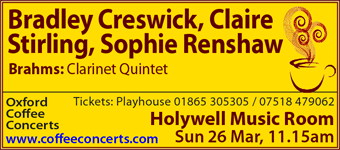A brilliantly sunny morning on Holywell St, though a fair few of the musical folk trickling in at the doors ready for their Janacek and Brahms seemed to have a hurried tread. Had they been caught out by the clocks going forward, or was the programme irresistible to them? Whichever was the case, Janacek's 'Kreutzer Sonata' string quartet was the hors d'oeuvre on the sinewy menu, and in his introduction to the piece, cellist Robin Michael told us this was a non-programmatic work, whose relation to the Tolstoy 1889 novella lay in the force of the emotions portrayed therein rather than direct reference to the narrative.
Janacek's remarkable late flowering as a composer of genius – his last 11 years from the age of 63 were ones of maximum productivity, when he became increasingly prominent in atonal composition - contrasts vividly with his early composing years when Franz Liszt, Tchaikovsky and Dvorak were living giants. This quartet is notable for the way in which material introduced is then re-worked, sometimes over and over again later on, in one or more of the four movements. Thus the two-bar theme that opens the piece pops up in the finale, both at the very start and at the very end. Violinist Bradley Creswick and his colleagues – a scratch grouping, not formal colleagues in an established ensemble – had to hit the ground running with this vigorous music and they did so. In the 2 nd movement, the viola and two violins in succession had to play with bow almost scraping the bridge, producing what the ever-excellent programme notes called "a hard, glassy sound". This is the kind of music that is a showcase for the technical sound possibilities of each instrument, particularly the violin. In the 4th movement Mr Creswick almost rose out of his seat with the emotional force he was packing into the tempestuous climax. Clarinettist Neyire Ashworth now joined the quartet and introduced a new seven minute composition of her own, a mourning threnody inspired by the death of viola player Sophie Renshaw's mother. The first section made little impression on me, though I noted that Ms Ashworth had not chosen to favour her own instrument. The development, however, offered the clarinet opportunities at the bottom of the register and an attractive, low-key melody became increasingly prominent. To those of us seated on the west side of the concert hall the white of the flowering cherry tree blossom could be seen peeping in at the east window, and there was a pleasing lighting effect as sunbeams picked out the forms of individual audience members, rather in the manner in which each instrument in turn was singled out by the concert's composers to play solo or lead the band in a figure.
We passed on to Brahms' Clarinet Quintet in B minor, a late work and one that Mike Wheeler's notes told us is "the supreme masterpiece" of the composer's last period.The clarinettist has to craft a tone sufficiently malleable to move from a state of understated introspection to a storm of intensity powerful enough to unleash (and ultimately resolve) a mighty catharsis of emotions. The crux of the challenge is, I think, in the heart and soul of this work - the long 'adagio' which to my ear has Mahlerian undertones. I cannot say I enjoyed Ms Ashworth's playing here: she seemed to be striving for a clear, pure tone that wouldn't come, and there were a surprising number of duff notes. Whether the problem can be laid at the door of under-rehearsal, I don't know. In the finale, however, with its variations on the initial simple theme, the clarinet was heard dexterously in the fourth of them and then in the fifth with its quick, triple time and sonorous plucking from the cello, we were swept along to a satisfying conclusion.




